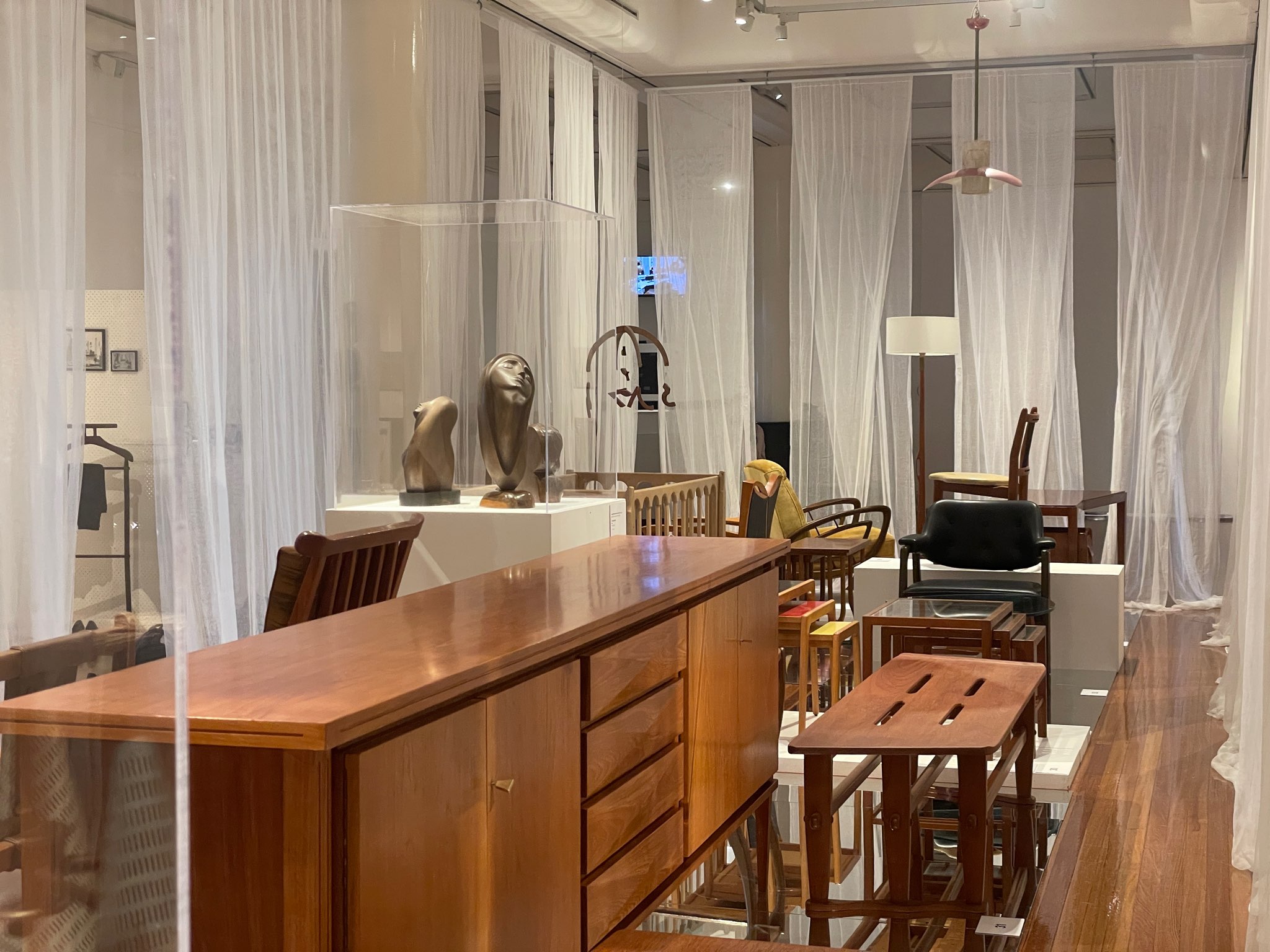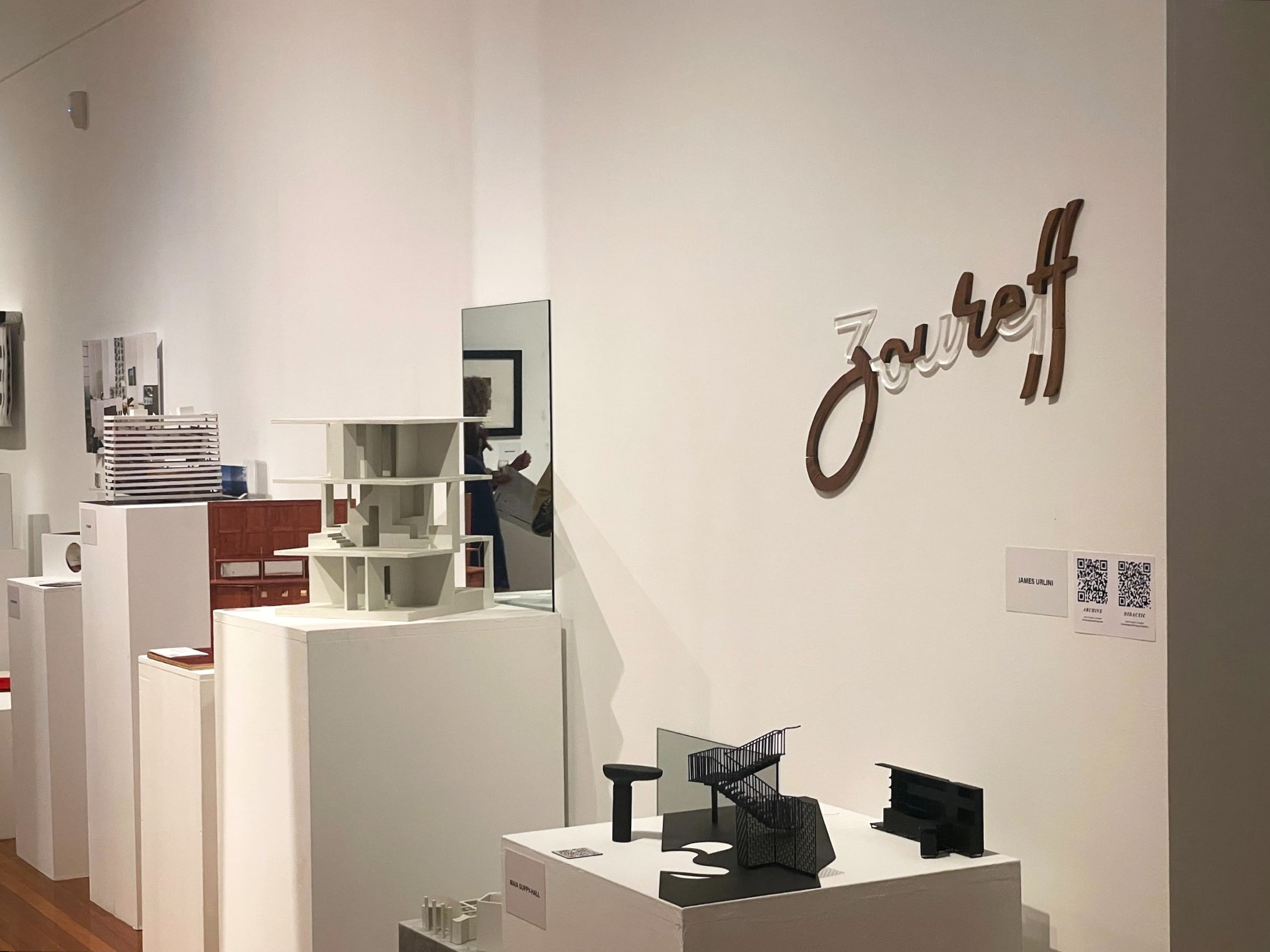







The Sign and The Mobile
2023
Art Direction, Poetry, Archival
2023
Art Direction, Poetry, Archival
Exhibited at Glen Eira City Council Gallery for The Endless Interior (from Austria to the Antipodes) 6 October–12 November, 2023.
Didactic Text:
Within the gallery a work in two parts, The Sign and The Mobile keys into an active conversation about attribution, lives, legacies, contexts, and communities. It focuses particularly on the work of furniture designer Dario Zoureff and that of his parents Aron and Irma, aiming to make visible a discussion of archives, narratives, and histories – interpolated and extrapolated, implicit and explicit.
Following their migration from Vienna to Melbourne in 1939, and after a few years of continuing their business as confectioners at 187 Barkly Street, St. Kilda, Aron and Irma Zoureff purchased 278-290 High Street, St. Kilda (now St. Kilda Road) in 1946. Over the years becoming known as the “Zoureff Building”, the six shopfronts and rear factory served as a hub for business and cultural exchange – selling goods ranging from confectionery, pottery, and glasswork to cacti and furniture.
The Sign, made of acrylic and blackwood, is based on a photograph shared on Instagram by Jeromie Maver of a young Dario in front of one of Zoureff Chocolates on High Street. Situated above Maia Guppy-Hall’s excerpted architectures of Bernard Slawik’s 1963 Baker House, for which Dario designed cabinetry, The Sign strives to resurrect a bygone era in the Zoureff family’s history. Intentionally fragmented it hints at a whole, yet pieces are noticeably absent, compelling the viewer to seek the missing elements elsewhere – reassembled in The Mobile, latent in the furnitures around us, within individual and collective memories, or in the silence, the tacit, and the unspoken.
More than a word, “Zoureff” contains a multifaceted significance – a family name, the legacies of multiple designers, a shopfront, a vendor, furniture, a selling point, and an architectural landmark. The Sign embodies an entire narrative, archive, material reality, and a set of memories yet it also contains gaps and mysteries – known and unknown.
The Mobile, features fragments of The Sign suspended above a cot designed by Dario. Its arched form references the cot’s formal language, while the three fish are derived from an advertisement for Zoureff’s Bambini Boutique in Vogue’s Guide to Living. Through The Mobile, the Zoureff cot – devoid of bedding and rendered an art object in this context – is provided, reunited perhaps, with an ideal partner. By hosting the displaced fragments of The Sign, The Mobile encourages us to peer beyond the surface, advocating for consideration of the intricate web of narratives and connections that underpin the collective histories of the works exhibited.
The Sign and The Mobile in tandem discuss the lives of these forgotten, hidden, removed and recontextualized works. They discuss the extrapolation, interpolation, and interpretation of archives and histories. In doing so, they act as vehicles for contextualization and contemplation. They transport us through time, offering a glimpse into the history and creativity of the Zoureff family, and prompt reflection on the interplay between the past, present, and the potential for the future. They offer a presence within this space, despite referencing the past. They remind us that within the walls of a building, gallery, shop, interior, and beyond these curtains, lie stories waiting to be rediscovered and reinterpreted.
Didactic Text:
Within the gallery a work in two parts, The Sign and The Mobile keys into an active conversation about attribution, lives, legacies, contexts, and communities. It focuses particularly on the work of furniture designer Dario Zoureff and that of his parents Aron and Irma, aiming to make visible a discussion of archives, narratives, and histories – interpolated and extrapolated, implicit and explicit.
Following their migration from Vienna to Melbourne in 1939, and after a few years of continuing their business as confectioners at 187 Barkly Street, St. Kilda, Aron and Irma Zoureff purchased 278-290 High Street, St. Kilda (now St. Kilda Road) in 1946. Over the years becoming known as the “Zoureff Building”, the six shopfronts and rear factory served as a hub for business and cultural exchange – selling goods ranging from confectionery, pottery, and glasswork to cacti and furniture.
The Sign, made of acrylic and blackwood, is based on a photograph shared on Instagram by Jeromie Maver of a young Dario in front of one of Zoureff Chocolates on High Street. Situated above Maia Guppy-Hall’s excerpted architectures of Bernard Slawik’s 1963 Baker House, for which Dario designed cabinetry, The Sign strives to resurrect a bygone era in the Zoureff family’s history. Intentionally fragmented it hints at a whole, yet pieces are noticeably absent, compelling the viewer to seek the missing elements elsewhere – reassembled in The Mobile, latent in the furnitures around us, within individual and collective memories, or in the silence, the tacit, and the unspoken.
More than a word, “Zoureff” contains a multifaceted significance – a family name, the legacies of multiple designers, a shopfront, a vendor, furniture, a selling point, and an architectural landmark. The Sign embodies an entire narrative, archive, material reality, and a set of memories yet it also contains gaps and mysteries – known and unknown.
The Mobile, features fragments of The Sign suspended above a cot designed by Dario. Its arched form references the cot’s formal language, while the three fish are derived from an advertisement for Zoureff’s Bambini Boutique in Vogue’s Guide to Living. Through The Mobile, the Zoureff cot – devoid of bedding and rendered an art object in this context – is provided, reunited perhaps, with an ideal partner. By hosting the displaced fragments of The Sign, The Mobile encourages us to peer beyond the surface, advocating for consideration of the intricate web of narratives and connections that underpin the collective histories of the works exhibited.
The Sign and The Mobile in tandem discuss the lives of these forgotten, hidden, removed and recontextualized works. They discuss the extrapolation, interpolation, and interpretation of archives and histories. In doing so, they act as vehicles for contextualization and contemplation. They transport us through time, offering a glimpse into the history and creativity of the Zoureff family, and prompt reflection on the interplay between the past, present, and the potential for the future. They offer a presence within this space, despite referencing the past. They remind us that within the walls of a building, gallery, shop, interior, and beyond these curtains, lie stories waiting to be rediscovered and reinterpreted.